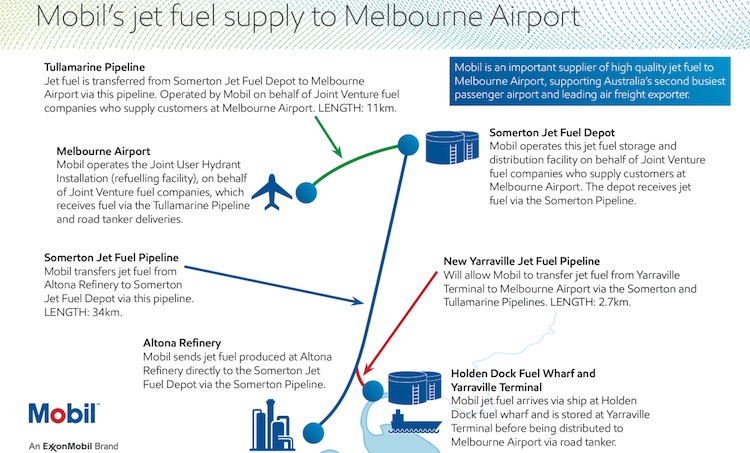Mobil Oil Australia plans to boost jet fuel supplies to Melbourne Tullamarine through the construction of a new pipeline that will link its Yarraville fuel distribution terminal to the airport’s main fuel storage depot.
The company said on Monday work on the 2.7km pipeline had commenced and would take 12 months to finish.
BP, Caltex, Mobil and Shell are joint-venture partners in the Joint User Hydrant Installation (JUHI), which owns and manages the fuel depot and hydrant infrastructure at Melbourne Airport. Mobil operates the facility, which receives fuel from the Somerton Jet Fuel Depot via an 11km pipeline or from road tanker deliveries.
Mobil also operates the Somerton Jet Fuel Depot, which stores and distributes fuel on behalf of the joint venture partners. The company supplies fuel to Somerton from its Altona Refinery along a 34km pipeline.
This new 2.7km Yarraville pipeline will link up with this 34km pipeline. Currently, jet fuel from Yarraville is taken to Tullamarine via road tankers. Mobil said the new Yarraville pipeline would help the company meet the growing demand for jet fuel at Tullamarine amid increasing passenger flows and more flights from airlines into and out of Australia’s second busiest airport.
“By providing a direct connection from Mobil’s Yarraville Terminal to the Somerton Pipeline, we will be able to more efficiently transport fuel from our terminal to Melbourne Airport, one of the area’s most important transportation assets,” Mobil manager of refining for Australia and New Zealand Andrew Warrell said in a statement on Monday.
A summary of the jet fuel arrangements at the airport is shown below:

Mobil said the Yarraville Terminal was the largest fuel storage and distribution terminal in Melbourne and supplied about one third of Victoria’s fuel needs.
In 2015, Melbourne Airport was twice faced with fuel rationing after the National Operating Committee on Jet Fuel Supply Assurance (NOC) changed the fuel supply status at Tullamarine to a “black traffic light”, which indicated the need to ration fuel.
The first incident took place in January, with another “black traffic light” issued in October.
The Board of Airline Representatives of Australia (BARA), which represents 29 international airlines that fly into and out of Australia, said following the second indecent in October it was becoming “increasingly obvious that airlines do not have access to a reliable and competitive fuel supply” at Tullamarine.
A BARA policy paper released in December 2014 called for reform of the jet fuel supply supply chain through opening up competition clearing bottlenecks.
“The Australian and Victorian governments need to consider if it’s in the nation’s interest to risk prosperity in Victorian aviation and tourism by allowing the current jet fuel suppliers to determine the reliability and competitive supply of jet fuel at Melbourne Airport,” BARA executive director Barry Abrams said in October 2015.
















Adrian P
says:I wonder how much longer Altona will be producing jet fuel?
Will we be relying on imported stock?
Raymond
says:Very sensible and welcome news.
Steve
says:No point building this asset with only 8ML of storage at the Melbourne airport.
Wombat
says:Once again the importance of a strategic fuel strategy is highlighted, as is the lack of a holistic approach by governments current and past, federal and state.